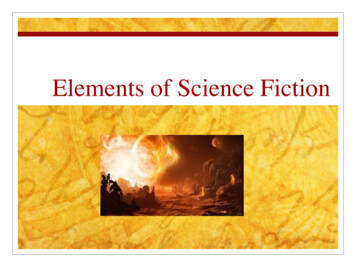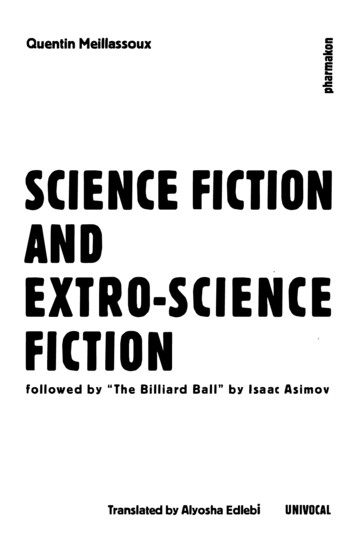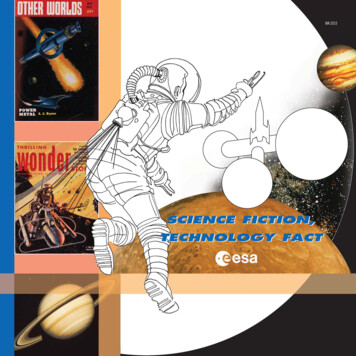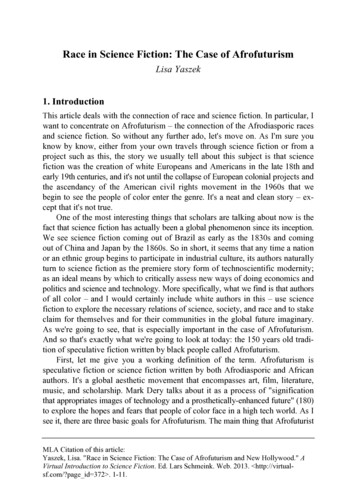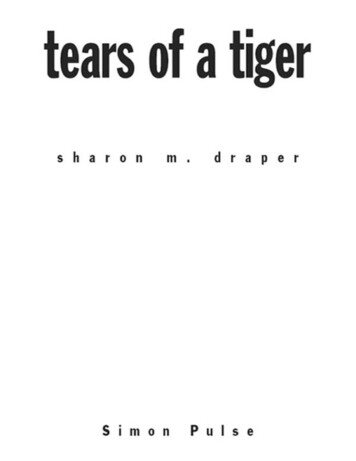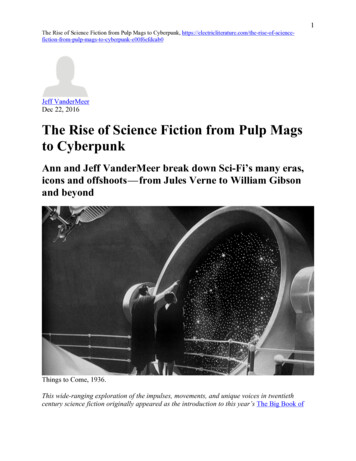
Transcription
1The Rise of Science Fiction from Pulp Mags to Cyberpunk, ff VanderMeerDec 22, 2016The Rise of Science Fiction from Pulp Magsto CyberpunkAnn and Jeff VanderMeer break down Sci-Fi’s many eras,icons and offshoots — from Jules Verne to William Gibsonand beyondThings to Come, 1936.This wide-ranging exploration of the impulses, movements, and unique voices in twentiethcentury science fiction originally appeared as the introduction to this year’s The Big Book of
2The Rise of Science Fiction from Pulp Mags to Cyberpunk, ience Fiction from Vintage Books. Ann and Jeff VanderMeer’s next project will be The BigBook of Classic Fantasy, also from Vintage.Since the days of Mary Shelley, Jules Verne, and H. G. Wells, science fiction has not just helpeddefine and shape the course of literature but reached well beyond fictional realms to influenceour perspectives on culture, science, and technology. Ideas like electric cars, space travel, andforms of advanced communication comparable to today’s cell phone all first found their way intothe public’s awareness through science fiction. In stories like Alicia Yáñez Cossío’s “The IWM100” from the 1970s you can even find a clear prediction of Information Age giants likeGoogle — and when Neil Armstrong set foot on the moon, the event was a very real culminationof a yearning already expressed through science fiction for many decades.Science fiction has allowed us to dream of a better world by creating visions of future societieswithout prejudice or war. Dystopias, too, like Ray Bradbury’s Fahrenheit 451, have had theirplace in science fiction, allowing writers to comment on injustice and dangers to democracy.Where would Eastern Bloc writers have been without the creative outlet of science fiction, whichby seeming not to speak about the present day often made it past the censors? For many underSoviet domination during those decades, science fiction was a form of subversion and a symbolof freedom. Today, science fiction continues to ask “What if?” about such important topics asglobal warming, energy dependence, the toxic effects of capitalism, and the uses of our moderntechnology, while also bringing back to readers strange and wonderful visions.No other form of literature has been so relevant to our present yet been so filled with visionaryand transcendent moments. No other form has been as entertaining, either. Before now, therehave been few attempts at a definitive anthology that truly captures the global influence andsignificance of this dynamic genre — bringing together authors from all over the world and fromboth the “genre” and “literary” ends of the fiction spectrum. The Big Book of Science Fictioncovers the entire twentieth century, presenting, in chronological order, stories from more thanthirty countries, from the pulp space opera of Edmond Hamilton to the literary speculations ofJorge Luis Borges, from the pre-Afrofuturism of W. E. B. Du Bois to the second-wave feminismof James Tiptree Jr. — and beyond!What you find within these pages may surprise you. It definitely surprised us.
3The Rise of Science Fiction from Pulp Mags to Cyberpunk, bert Heinlein, L. Sprague de Camp, and Isaac Asimov, Philadelphia Navy Yard, 1944.What Is the “Golden Age” of Science Fiction?Even people who do not read science fiction have likely heard the term “the Golden Age ofScience Fiction.” The actual Golden Age of Science Fiction lasted from about the mid-1930s tothe mid-1940s, and is often conflated for general readers with the preceding Age of the Pulps(1920s to mid-1930s). The Age of the Pulps had been dominated by the editor of AmazingStories, Hugo Gernsback. Sometimes called the Father of Science Fiction, Gernsback was mostfamously photographed in an all-encompassing “Isolator” author helmet, attached to an oxygentank and breathing apparatus.The Golden Age dispensed with the Isolator, coinciding as it did with the proliferation ofAmerican science fiction magazines, the rise of the ultimately divisive editor John W. Campbellat Astounding Science Fiction (such strict definitions and such a dupe for Dianetics!), and aproto-market for science fiction novels (which would only reach fruition in the 1950s). Thisperiod also saw the rise to dominance of authors like Isaac Asimov, Arthur C. Clarke, PoulAnderson, C. L. Moore, Robert Heinlein, and Alfred Bester. It fixed science fiction in the publicimagination as having a “sense of wonder” and a “can-do” attitude about science and theuniverse, sometimes based more on the earnest, naïve covers than the actual content, whichcould be dark and complex.But “the Golden Age” has come to mean something else as well. In his classic, oft-quoted bookon science fiction, Age of Wonders: Exploring the World of Science Fiction (1984), the iconicanthologist and editor David Hartwell asserted that “the Golden Age of Science Fiction is 12.”Hartwell, an influential gatekeeper in the field, was making a point about the arguments that“rage until the small of the morning” at science fiction conventions among “grown men andwomen” about that time when “every story in every magazine was a master work of daring,original thought.” The reason readers argue about whether the Golden Age occurred in the1930s, 1950s, or 1970s, according to Hartwell, is because the true age of science fiction is theage at which the reader has no ability to tell good fiction from bad fiction, the excellent from the
4The Rise of Science Fiction from Pulp Mags to Cyberpunk, rrible, but instead absorbs and appreciates just the wonderful visions and exciting plots of thestories.This is a strange assertion to make, one that seems to want to make excuses. It’s often repeatedwithout much analysis of how such a brilliant anthology editor also credited with bringingliterary heavyweights like Gene Wolfe and Philip K. Dick to readers would want to(inadvertently?) apologize for science fiction while at the same time engaging in a sentimentalitythat seems at odds with the whole enterprise of truly speculative fiction. (Not to mention dissingtwelve-year-olds!)Perhaps one reason for Hartwell’s stance can be found in how science fiction in the UnitedStates, and to some extent in the United Kingdom, rose out of pulp magazine delivery systemsseen as “low art.” A pronounced “cultural cringe” within science fiction often combines with thebrutal truth that misfortunes of origin often plague literature, which can assign value based onhow swanky a house looks from the outside rather than what’s inside. The new Kafka who nextarises from cosmopolitan Prague is likely to be hailed a savior, but not so much the one whoarises from, say, Crawfordville, Florida.There is also something of a need to apologize for the ma-and-pop tradition exemplified by thepulps, with their amateurish and eccentric editors, who sometimes had little formal training andpossessed as many eccentricities as freckles, and who came to dominate the American sciencefiction world early on. Sometimes an Isolator was the least of it.Yet even with regard to the pulps, evidence suggests that these magazines at times entertainedmore sophisticated content than generally given credit for, so that in a sense an idea like “theGolden Age of Science Fiction is 12” undermines the truth about such publications. It alsorenders invisible all of the complex science fiction being written outside of the pulp tradition.Therefore, we humbly offer the assertion that contrary to popular belief and based on all of theevidence available to us . . . the actual Golden Age of Science Fiction is twenty-one, not twelve.The proof can be found in the contents of this anthology, where we have, as much as possible,looked at the totality of what we think of “science fiction,” without privileging the dominantmode, but also without discarding it. That which may seem overbearing or all of a type at firstglance reveals its individuality and uniqueness when placed in a wider context. At third or fourthglance, you may even find that stories from completely diffrent traditions have commonalitiesand speak to each other in interesting ways.
5The Rise of Science Fiction from Pulp Mags to Cyberpunk, ath of Curate, Henrique Alvim Correa. War Of The Worlds Illustrations, 1906Building a Better Definition of “Science Fiction”We evoked the names of Mary Shelley, Jules Verne, and H. G. Wells at the beginning of thisintroduction for a very specific reason. All three are useful entry points or origin points forscience fiction because they do not exist so far back in time as to make direct influence seemethereal or attenuated, they are still known in the modern era, and because the issues they dealtwith permeate what we call the “genre” of science fiction even today.We hesitate to invoke the slippery and preternatural word influence, because influence appearsand disappears and reappears, sidles in and has many mysterious ways. It can be as simple yetprofound as reading a text as a child and forgetting it, only to have it well up from thesubconscious years later, or it can be a clear and all-consuming passion. At best we can only saythat someone cannot be influenced by something not yet written or, in some cases, not yettranslated. Or that influence may occur not when a work is published but when the writer entersthe popular imagination — for example, as Wells did through Orson Welles’s infamous radiobroadcast of War of the Worlds (1938) or, to be silly for a second, Mary Shelley through themovie Young Frankenstein (1974).For this reason even wider claims of influence on science fiction, like writer and editor Lester delRey’s assertion that the Mesopotamian Epic of Gilgamesh is the earliest written science fictionstory, seem appropriative, beside the point, and an overreach for legitimacy more useful as a“tell” about the position of science fiction in the 1940s and 1950s in North America.But we brought up our triumvirate because they represent different strands of science fiction.The earliest of these authors, Mary Shelley, and her Frankenstein (1818), ushered in a modernsensibility of ambivalence about the uses of technology and science while wedding thespeculative to the horrific in a way reflected very early on in science fiction. The “mad scientist”
6The Rise of Science Fiction from Pulp Mags to Cyberpunk, ope runs rife through the pages of the science fiction pulps and even today in their modernequivalents. She also is an important figure for feminist SF.Jules Verne, meanwhile, opened up lines of inquiry along more optimistic and hopeful lines. Forall that Verne liked to create schematics and specific detail about his inventions — like thesubmarine in Twenty Thousand Leagues Under the Sea (1870) — he was a very happy puppywho used his talents in the service of scientific romanticism, not “hard science fiction.”H. G. Wells’s fiction was also dubbed “scientific romanticism” during his lifetime, but his workexisted somewhere between these two foci. His most useful trait as the godfather of modernscience fiction is the granularity of his writing. Because his view of the world existed at anintersection of sociology, politics, and technology, Wells was able to create complex geopoliticaland social contexts for his fiction — indeed, after he abandoned science fiction, Wells’s laternovels were those of a social realist, dealing with societal injustice, among other topics. He wasable to quantify and fully realize extrapolations about the future and explore the iniquities ofmodern industrialization in his fiction.The impulse to directly react to how industrialization has affected our lives occurs very early onin science fiction — for example, in Karl Hans Strobl’s cautionary factory tale “The Triumph ofMechanics” (1907) and even in the playful utopian visions of Paul Scheerbart, which oftenpushed back against bad elements of “modernization.” (For his optimism, Scheerbart perished inWorld War I, while Strobl’s “reward” was to fall for fascism and join the Nazi Party — in part, akind of repudiation of the views expressed in “The Triumph . . .”)
7The Rise of Science Fiction from Pulp Mags to Cyberpunk, E.B Du Bois in 1918Social and political issues also peer out from science fiction from the start, and not just inWells’s work. Rokheya Shekhawat Hossein’s “Sultana’s Dream” (1905) is a potent feministutopian vision. W. E. B. Du Bois’s “The Comet” (1920) isn’t just a story about an impendingscience-fictional catastrophe but also the start of a conversation about race relations and a protoAfrofuturist tale. The previously untranslated Yefim Zozulya’s “The Doom of Principal City”(1918) presages the atrocities perpetrated by the communism of the Soviet Union and highlightsthe underlying absurdities of certain ideological positions. (It’s perhaps telling that these earlyexamples do not come from the American pulp SF tradition.)This kind of eclectic stance also suggests a simple yet effective definition for science fiction: itdepicts the future, whether in a stylized or realistic manner. There is no other definitional barrierto identifying science fiction unless you are intent on defending some particular territory.Science fiction lives in the future, whether that future exists ten seconds from the Now orwhether in a story someone builds a time machine a century from now in order to travel backinto the past. It is science fiction whether the future is phantasmagorical and surreal or naileddown using the rivets and technical jargon of “hard science fiction.” A story is also sciencefiction whether the story in question is, in fact, extrapolation about the future or using the futureto comment on the past or present.
8The Rise of Science Fiction from Pulp Mags to Cyberpunk, ience fiction lives in the future, whether that future exists ten seconds from the Now orwhether in a story someone builds a time machine a century from now in order to travel backinto the past.Thinking about science fiction in this way delinks the actual content or “experience” deliveredby science fiction from the commodification of that genre by the marketplace. It does notprivilege the dominant mode that originated with the pulps over other forms. But neither does itprivilege those other manifestations over the dominant mode. Further, this definition eliminatesor bypasses the idea of a “turf war” between genre and the mainstream, between commercial andliterary, and invalidates the (weird ignorant snobbery of) tribalism that occurs on one side of thedivide and the faux snobbery (ironically based on ignorance) that sometimes manifests on theother.Wrote the brilliant editor Judith Merril in the seventh annual edition of The Year’s Best S-F(1963), out of frustration:“But that’s not science fiction . . . !” Even my best friends (to invert a paraphrase) keep tellingme: That’s not science fiction! Sometimes they mean it couldn’t be s-f, because it’s good.Sometimes it couldn’t be because it’s not about spaceships or time machines. (Religion orpolitics or psychology isn’t science fiction — is it?) Sometimes (because some of my best friendsare s-f fans) they mean it’s not really science fiction — just fantasy or satire or something likethat.On the whole, I think I am very patient. I generally manage to explain again, just a little wearily,what the “S-F” in the title of this book means, and what science fiction is, and why the onecontains the other, without being constrained by it. But it does strain my patience when theexclamation is compounded to mean, “Surely you don’t mean to use that? That’s not sciencefiction!” — about a first-rate piece of the honest thing.Standing on either side of this debate is corrosive — detrimental to the study and celebration ofscience fiction; all it does is sidetrack discussion or analysis, which devolves into SF/not SF orintrinsically valuable/not valuable. And, for the general reader weary of anthologies prefaced bya series of “inside baseball” remarks, our definition hopefully lessens your future burden ofreading these words.
9The Rise of Science Fiction from Pulp Mags to Cyberpunk, lvina OcampoConsider Another Grand Tradition: The Conte PhilosophiqueInasmuch as we have put on our Isolator and already paid some tribute to the “dominant” strainof science fiction by briefly conjuring up the American pulp scene of the 1920s through 1940s, itis important before returning to that tradition to examine what the Loyal Opposition was up to inthe first half of the twentieth century — and for this reason, it is important to turn our attention toan earlier form, the conte philosophique.Conte philosophique translates as “philosophical story” or “fable of reason.” The contesphilosophiques were used for centuries in the West by the likes of Voltaire, Johannes Kepler, andFrancis Bacon as one legitimate way for scientists or philosophers to present their findings. Theconte philosophique employs the fictional frame of an imaginary or dream journey to impartscientific or philosophical content. In a sense, the fantastical or science-fictional adventurebecame a mental laboratory in which to discuss findings or make an argument.If we position some early science fiction as occurring outside of the American pulp tradition butalso outside of traditions exemplified by Mary Shelley and H. G. Wells, what remains asinfluence is both extremely relevant to science fiction and also relevant to more dominanttraditions.Early twentieth-century science fiction like Hossein’s “Sultana’s Dream,” Scheerbart’s utopianfables, or Alfred Jarry’s “Elements of Pataphysics” from his novel Exploits and Opinions of Dr.Faustroll, Pataphysician (1911; first published in English in the 1960s) makes infinitely moresense in this context. More importantly, these stories take their rightful place within the historyof speculative literature. Instead of being considered outliers, they can be seen as the evolution ofa grand tradition, one that inverts the usual ratio of the fictional to nonfictional found in a typical
10The Rise of Science Fiction from Pulp Mags to Cyberpunk, nte philosophique. It is a mode that certainly helps us better understand Jules Verne’s fiction.In many cases, Verne was taking his cue from the trappings of the conte philosophique — thefantastical adventure — and using that form as a vehicle for creating his entertainments.The conte philosophique, with its non/fictional fusion, also creates a fascinating link to JorgeLuis Borges and his essay-stories from the 1940s. These stories often serve as a vehicle formetaphysical exploration. Indeed, Borges’s work can in this context be seen as the perfectexpression of and reconciliation of the (pulpish) adventure fiction he loved and the intellectualunderpinnings of his narratives, which rely in part on severe compression into tale (coal intodiamonds) rather than traditional short story. Other Latin American examples include SilvinaOcampo’s “The Waves” (1959) and Alicia Yáñez Cossío’s “The IWM 1000” (1975). EvenStanisław Lem in his Star Diaries voyages of the 1960s and 1970s is reimagining the contesphilosophiques — there is the actual voyage (exciting enough!) but it is once again a puredelivery system for ideas about the world.Although this tradition is not as common in the pulps, “science fiction tales” like A. Merritt’s“The Last Poet and the Robots” (1935) and Frederik Pohl’s “Day Million” (1966) can be seen asa fusion of the “speculative fairy tale” and the conte philosophique, or simply a mutation of theconte philosophique, which was itself influenced by ancient myths of fantastical journeys.Ironically, some of these stories add in elements of “hard science fiction.” Interpreted charitablyand not from a position espousing the superiority of the conte philosophique, this form infiltratesthe pulps in the sense that the pulps showcase the physical actuality of the contesphilosophiques — they are contes physiques into which can be reinjected or refed an abstractquality — “what/why/how/if?” And they can embody that quality or kind of inquiry as subtext.(Whereas on the mainstream side of the divide that subtext must manifest as metaphysics to beconsidered literature or be doomed in terms of approval — as would any non-character-basedfiction.)In this context, whether just as a thought experiment to turn the tables and challenge dominantmodes of thinking, or as a subversive “real” metaphorical or metaphysical construct, we couldthen come to see American pulp space-travel fiction as a kind of devolution — a mistake in whichthe scaffolding (or booster rockets) used to deliver the point of a conte philosophique (thejourney) is brought to the foreground and the idea or scientific hypothesis (the “what if”) isdeemphasized or subtextual only. A case of throwing out the baby to glorify the bathwater?Science fiction in the United States has often positioned itself as the “literature of ideas,” yetwhat is a literature of ideas if they can only be expressed through a select few “deliverysystems”? Aren’t there ideas expressed in fiction that we can only see the true value of — good orbad, sophisticated or simple — if we admit that there are more than a few modes of expressionwith which to convey them? In examining the link between the conte philosophique and sciencefiction, we begin to grasp the outlines of the wider context: how many of these “alternative”approaches are — rather than being deformed or flat or somehow otherwise suspect as lessermodes — just different from the dominant model, not lesser, and as useful and relevant. (Forexample, where otherwise to fit Czechoslovakian writer Karel Čapek — both his 1920s robotplays and his gonzo novel War with the Newts from the 1930s?)
11The Rise of Science Fiction from Pulp Mags to Cyberpunk, st like our definition of science fiction, this way of thinking about science fiction works bothfrom the “literary mainstream” looking in or from genre looking out. The reason it works is thatthe position or stance — the perspective or vantage taken — is from outside of either. And this isin a sense pure or uncontaminated by the subjective intent — colonizing or foundationallyassumed superior — of either “mainstream” literary or genre.In taking this position (on a mountaintop, from a plane, in a dirigible, from the moon, within adream journey) much less is rendered invisible in general, and more “viable” science fiction canbe recovered, uncovered, or discovered without being any less faithful about our core definition.Thus, too, in this anthology we have the actuality of exploration and the idea of it, because boththought and action expend energy and are both, in their separate ways, a form of motion.Perhaps the reason the conte philosophique to date has been undervalued as an influence onscience fiction is because of the “cultural cringe” of the dominant American form of sciencefiction, which has consistently positioned itself in relationship to the literary mainstream byaccepting the literary mainstream’s adherence to the short story as needing to have threedimensional, psychologically convincing characters to be valid. Even reactions against thisposition (pre-Humanist SF) have in essence been defining science fiction in relationship to theüber-domination of the mainstream.This is particularly ironic given that a fair amount of early science fiction fails at the task ofcreating three-dimensional characters (while displaying other virtues) and thus as the centuryprogresses the self-punishment the science fiction genre parcels out to itself for not meeting astandard that is just one tradition within the mainstream looks increasingly odd, or even perverse,as are excuses like “the Golden Age of Science Fiction is 12.” The genre would have been farbetter off taking up the cause of traditions like the conte philosophique to bypass mainstreamapprobation rather than continually recycling the Mesopotamian Defense or the HawthorneManeuver (“Canon fodder Nathaniel Hawthorne was the first science fiction/fantasy writer”) tocreate legitimacy or “proof of concept” on the mainstream’s terms.
12The Rise of Science Fiction from Pulp Mags to Cyberpunk, ird Tales, July 1944.Further Exploration of the Pulp TraditionRemember the Age of the Pulps and later Golden Age of Science Fiction (the 1920s to mid1940s)? Collectively, this era successfully exported itself as a system of plots, tropes, storystructures, and entanglements to either emulate or push back against. It was typified not so muchby movements as by the hegemonies created by particular influential editors like H. L. Gold, theaforementioned Campbell, and Frederik Pohl (at Galaxy).Many of these editors, trying to create an advantage in the marketplace, created their ownfiefdom, defended borders, laid down ground rules for what science fiction was and what itwasn’t. In some cases, it might be argued they had to because no one yet knew exactly what itwas, or because enthusiasts kept encountering new mutations. These rules in the cutthroat andstill-stuffy world of freelance writing could affect content quite a bit — Theodore Sturgeonreportedly stopped writing for a time because of one editor’s rules. Writers could make a livingwriting for the science fiction magazines in an era with no competition from television or videogames — and they could especially make a living if they obeyed the dictates of their editor-kings.These editorial tastes would come to define, even under new editors, the focus of magazines likeAmazing Stories, even if editorial tastes are not sound or rational systems of thought. Still, theyshape taste and canon as much or more so than stable systems or concrete movements — in partbecause the influence of editors often exists out of the public eye and thus is less subject to opendebate.Writers could make a living writing for the science fiction magazines in an era with nocompetition from television or video games — and they could especially make a living if theyobeyed the dictates of their editor-kings.In a few other cases, magazines like Weird Tales successfully forged identities by championinghybrid or new modes of fiction, to the point of becoming synonymous with the type of contentthey provided to readers. Dashing men in dashing machines having dashing adventures were notas prevalent in such magazines, nor in this Golden Age era. It was more likely that the dashingman might have a dashing accident and be dashed up on some malign alien world or be facedwith some dashing Terrible Choice based on being dashed on the rocks of misfortune.In fact, much written in the mode of purely optimistic fiction has not aged well — in part becauseit simplified the complexities of a very complex world and the universe beyond. For example,with each decade what we know about what it takes to travel in space makes it more and moreunlikely that we will make it out of our own solar system. Even one of the foremost supporters ofterraforming, Kim Stanley Robinson, admitted that such travel is highly improbable in a 2014interview.The other reason this brand of science fiction has mostly historical value is because the twentiethcentury included two world wars along with countless significant regional conflicts, the creation
13The Rise of Science Fiction from Pulp Mags to Cyberpunk, fiction-from-pulp-mags-to-cyberpunk-e00f6efdcab0of the atom bomb, the spread of various viruses, ecological disaster, and pogroms in Europe,Asia, and Africa.Against such a growing tally, certain kinds of “gee-whiz” science fiction seem hopelessly out ofdate; we need escapism in our fiction because fiction is a form of play, but escapism becomesdifficult to read when it renders invisible the march of history or becomes too disconnected fromreaders’ experience of science, technology, or world events. When you also throw in institutionalracism in the United States, a subject thoroughly ignored by science fiction for a very long time,and other social issues dealt with skillfully by non-SF through the first five decades of thetwentieth century, it perhaps makes sense that there is very little from the Golden Age of ScienceFiction in this anthology. Our representative choices are ones where the predictive nature of thestory or its sophistication stands up to the granularity of the present day.It is also worth remembering that in the wider world of literature writers outside of sciencefiction were trying to grapple with the changing nature of reality and technological innovation.After World War I, James Joyce, T. S. Eliot, Virginia Woolf, and others experimented with thenature of time and identity in ways that at times had a speculative feel to it. These weremainstream attempts to engage with science (physics) that only entered into
Ann and Jeff VanderMeer break down Sci-Fi’s many eras, icons and offshoots— from Jules Verne to William Gibson and beyond Things to Come, 1936. This wide-ranging exploration of the impulses, movements, and unique voices in twentieth century science fiction originally ap


